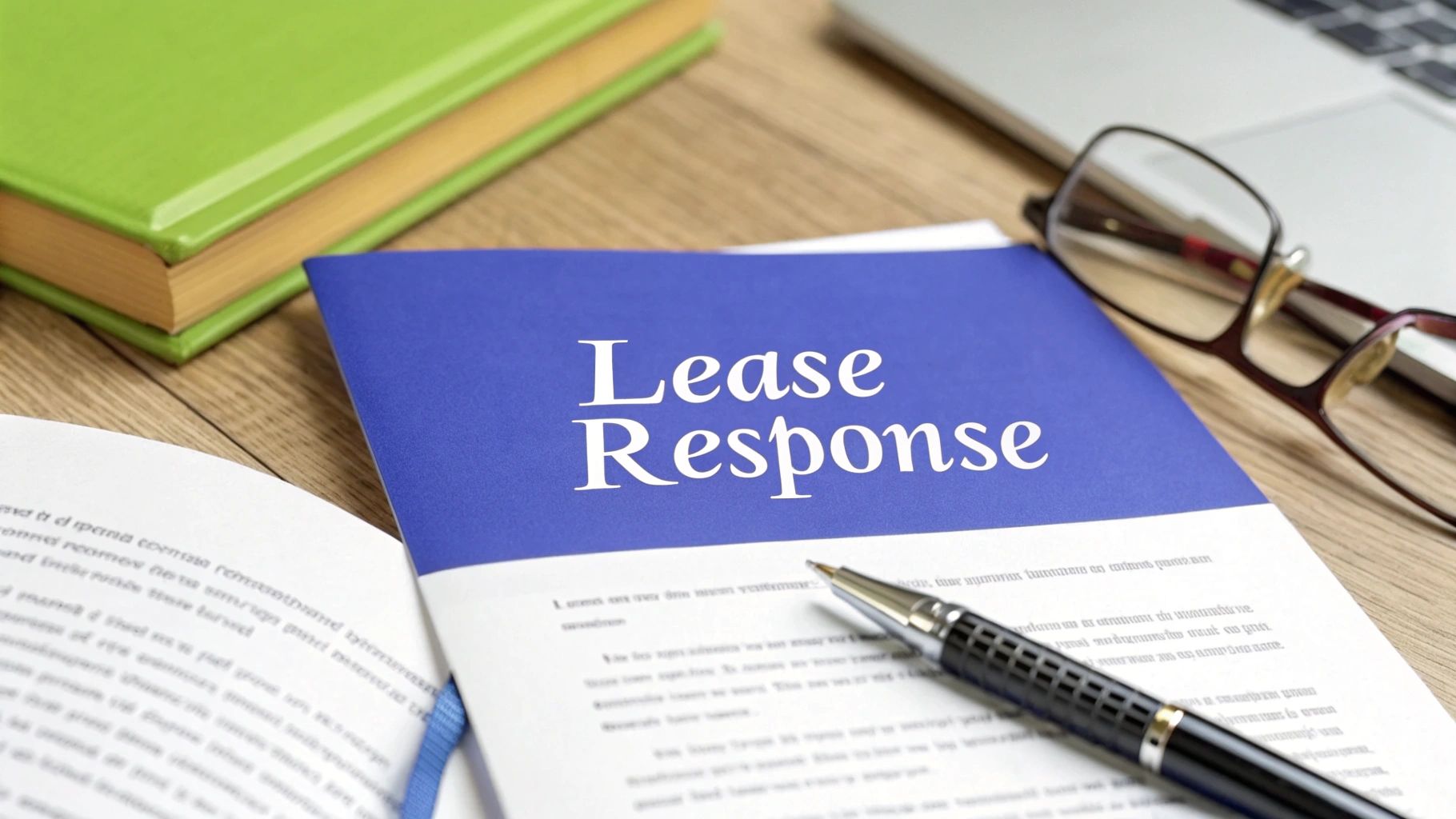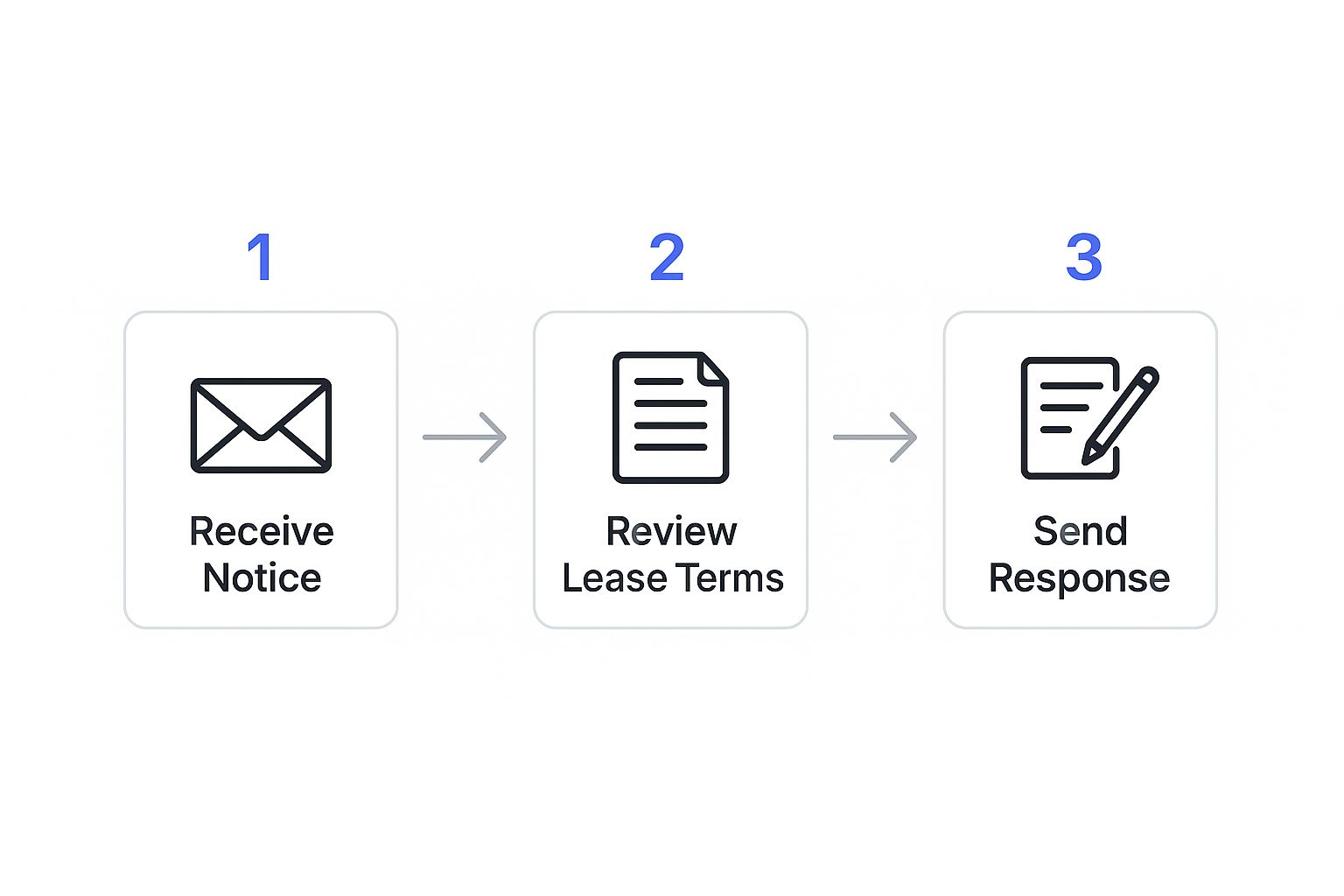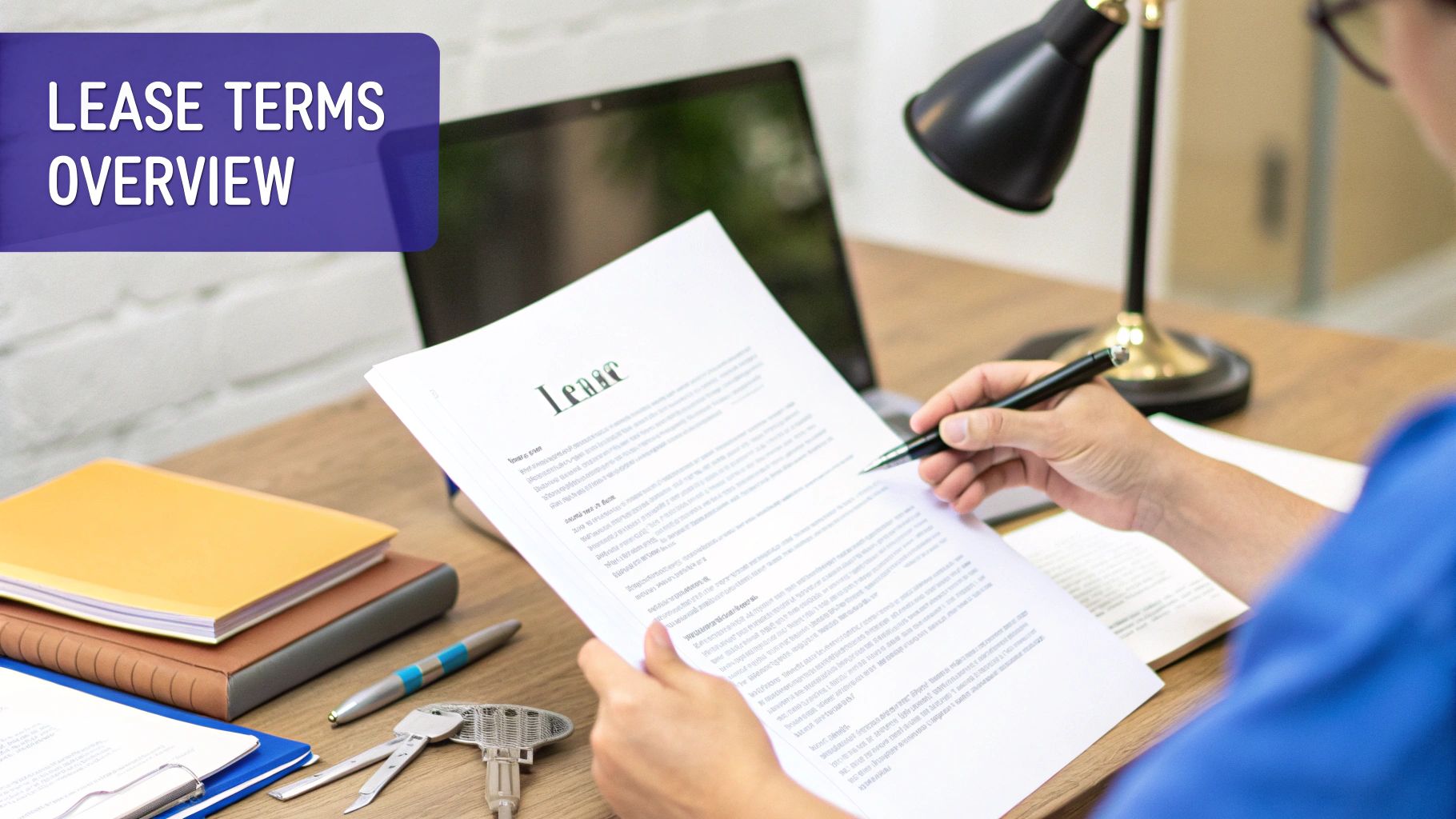
Receiving a formal notice from your landlord can be unnerving. That official-looking paper taped to your door is designed to get your attention, and it usually works—often by sending a jolt of anxiety through you.
But before you let panic set in or dash off a heated email, just take a breath. What you do in the first 24 hours is critical. It sets the tone for everything that follows. The goal here isn't to react emotionally but to act strategically.
Think of yourself as a detective. Your first job is to get the facts straight.
What to Do Immediately After Getting a Notice
First things first, read the notice carefully. Then read it again. You're looking for two key pieces of information: the what and the when.
Pinpoint the Exact Problem
Your landlord should spell out the exact issue. Is it a noise complaint? An unauthorized pet? A late rent payment? The notice must state the specific violation and, just as importantly, reference the clause in your lease agreement you've supposedly breached.
Jot down that clause number. You'll need it in a minute when you pull out your own copy of the lease to cross-reference their claim.
Understand Your Deadline
Next, find the deadline. This might be the single most important detail on the page. The notice will give you a specific timeframe to "cure" (or fix) the violation. This window can be shorter than you think.
For instance, in states like Texas, the notice period to fix an issue can be as little as three days. Responding promptly and documenting your compliance is your best legal protection. The clock starts ticking the moment you get that notice, and missing the deadline—even by a day—can give your landlord grounds to escalate things, potentially leading to eviction proceedings. For more on this, OECD.org offers insights into eviction processes and why timing is so crucial.
Key Takeaway: The deadline isn't a suggestion. Treat it as a hard stop and plan your response accordingly.
To help you get organized quickly, here's a simple checklist breaking down what to look for and what to do right away.
Your Initial Notice Checklist
This table cuts through the noise and shows you exactly what to focus on in that first read-through.
| Notice Component | What It Means for You | Your First Action |
|---|---|---|
| Violation Details | This is the specific reason for the notice (e.g., "unauthorized pet," "late rent"). | Identify the core complaint. Don't get distracted by other language. |
| Lease Clause Reference | The landlord must cite the exact rule you've allegedly broken. | Find this clause number in your personal copy of the lease agreement. |
| Cure or Quit Date | This is your non-negotiable deadline to either fix the issue or move out. | Circle this date. It dictates the urgency of your next steps. |
| Landlord Contact Info | The official person or office you need to communicate with. | Note the name and contact details for your formal written response. |
This checklist is your starting point. Once you have these details, you're no longer reacting—you're preparing a measured, professional response.

The image above visualizes this simple, three-part process: get the notice, check your lease, and then send a formal response. Sticking to this logical path helps keep emotion out of it and puts you in a much stronger position to resolve the problem.
Decoding the Landlord's Claim

Okay, you've got the notice and you know your deadline. Now for the most important part: figuring out what your landlord is actually claiming and if it holds any water.
Not all lease violations are the same. Some are minor slip-ups, while others are serious breaches of your rental agreement. How you respond depends entirely on what the notice says—and whether it's actually true.
Your single most powerful tool right now is your original lease agreement. It's the only source of truth that matters. Go find it, and lay it down right next to the violation notice.
Scrutinize the Specific Allegation
A legitimate notice can't just be a vague complaint. Your landlord must point to a specific clause in the lease they believe you've violated. Your first job is to find that exact clause.
Does the lease say what they claim it says? For example, a notice for "improper trash disposal" might have been triggered because you left a bag out overnight. But what if your lease only says trash must be in the designated bins, with no mention of timing? That's a huge difference, and it's the kind of detail that can completely change your response.
Pro Tip: If your lease is packed with dense legalese, don't just guess what it means. Using a tool to simplify the language can be a lifesaver, ensuring you don't misinterpret a key clause that could make or break your case.
Common Violation Categories
Lease violations usually fall into a few buckets. Knowing which one you're dealing with helps you figure out the best way to respond.
- Monetary Violations: This is the most black-and-white category. It's almost always about unpaid rent or utilities. The cure is simple: pay what you owe.
- Minor Infractions: Think unauthorized decorations, parking in the wrong spot, or a one-off noise complaint. These are typically easy to fix within the notice period.
- Significant Breaches: This is a step up. We're talking about things like an unauthorized long-term guest, a secret pet in a no-pet building, or making unapproved changes to the apartment.
- Severe Violations: These are the big ones that can lead straight to an eviction filing, like illegal activity or causing major property damage.
It can also be helpful to see things from the other side. Checking out common landlord resources can give you a peek into their perspective and help you anticipate their next moves.
Confirming the Claim's Validity
After you've compared the notice to your lease, it's time for some honest self-assessment. Did you actually break the rule?
If the answer is yes, your path is pretty clear: fix the problem immediately and let your landlord know you've done so. But if the claim is bogus, exaggerated, or based on a misreading of the lease, your response shifts to a formal dispute.
This analysis is more than just a formality—it dictates your entire strategy from here on out. If you're digging into the fine print, our guide on https://legaldocumentsimplifier.com/blog/what-to-look-for-in-a-lease-agreement has some great insights that can really strengthen your position.
How to Write a Response to a Lease Violation Notice
Getting a lease violation notice feels personal, but your response needs to be professional. This letter isn't just a quick reply—it's a legal document that creates an official record of your side of the story. How you write it can genuinely change the outcome.
The key is to set the right tone from the very start. Forget being defensive or overly formal. Aim for clear, calm, and strategic. Whether you messed up or the notice is completely wrong, a non-confrontational approach shows you're taking this seriously and are willing to find a solution.
Remember, the property manager or landlord reading your letter is often just following a process. A respectful tone makes them far more likely to work with you.
Structure Your Letter for Maximum Impact
A well-organized letter gets your point across without confusion. I always tell tenants to think of it in three simple parts: the intro, the body, and the closing.
- The Opening: Jump straight to the point. Identify yourself, your unit number, and the date of the violation notice you're responding to. This ensures everyone is on the same page.
- The Body: This is the core of your letter. It’s where you’ll directly address the violation, and what you say depends entirely on whether you agree or disagree with the claim.
- The Closing: Wrap it up professionally. State your commitment to fixing the issue and provide your phone number and email address.
This simple framework creates a logical flow that makes your position easy to follow.
Responding effectively comes down to three things: knowing your rights, acting fast, and keeping communication open. Tackling the issue head-on reduces the risk of things escalating, like eviction proceedings, and helps keep your housing secure.
Writing the Body: Agreeing vs. Disagreeing
This is where you make your case, so be direct and stick to the facts. The content will look very different depending on your situation.
If You Agree with the Violation
Look, sometimes you're in the wrong. If the notice is accurate, the best move is to own it, explain how you've fixed it (or will), and give a clear timeline.
- Acknowledge the Issue: Start by admitting the violation. A simple, "I am writing in response to your notice from [Date] regarding the unauthorized satellite dish" works perfectly.
- State Your Corrective Action: Immediately explain what you've done. For example, "The dish has been removed, and I will ensure I adhere to the property's rules moving forward."
- Provide a Clear Timeline: If the fix isn't instant, give a specific deadline. "I have scheduled bulk pickup for the old mattress on the patio, and it will be gone by this Saturday, [Date]."
If You Disagree with the Violation
If the notice is mistaken, your response needs to be firm but polite. This is where evidence is everything.
- State Your Disagreement Clearly: Open by politely denying the claim. "I am writing to formally dispute the lease violation notice dated [Date] concerning an unauthorized pet."
- Provide Cold, Hard Evidence: This is your most powerful tool. Attach any proof you have. For instance, "My downstairs neighbor was pet-sitting for her sister that week. I have attached a signed letter from her confirming the dog was hers and is no longer on the property."
- Point to the Lease Agreement: If the issue is a misunderstanding of the lease terms, cite the specific clause. "Per section 7.C. of our lease, residents are permitted to have two vehicles. My car and motorcycle are both registered to this address, which is within the agreed-upon limit."
Finalizing and Sending Your Letter
Once you've written your draft, proofread it. Then proofread it again. Typos and grammatical errors can make you seem less credible.
Finally, think about how you'll send it. Email is quick and provides a digital record, but sending the letter via certified mail is the gold standard. It gives you a legal receipt proving your landlord received it on a specific date. It’s a small step that offers huge protection if the situation ever escalates.
Opening a Dialogue with Your Landlord

Getting a lease violation notice can feel like a final judgment, but it’s usually just the beginning of a conversation. Instead of treating it like a confrontation, see it for what it is: an opportunity to open a dialogue with your landlord or property manager. Good communication can de-escalate a tense situation and turn it into a solvable problem.
So many of these issues boil down to simple misunderstandings. Maybe the landlord got a report about an unauthorized pet, but you were just watching a friend's dog for the weekend. If you approach the conversation ready to clarify the situation, you’ll get a lot further than if you immediately go on the defensive.
The goal here is to find some common ground. Remember, most landlords would much rather keep a reliable, paying tenant than deal with the cost and headache of finding a new one. That gives you more leverage than you probably think.
Getting Ready for a Productive Conversation
Before you even think about picking up the phone or drafting an email, figure out your endgame. What’s the ideal resolution for you? Are you just looking for a bit more time to fix the problem, or do you need to propose a bigger compromise?
Let’s say you brought a cat into a building with a strict "no pets" policy. Your objective might be to negotiate an exception. You could prepare an offer, like paying a one-time pet fee or adding a small amount to your monthly rent. Frame it as a win-win: they keep a great tenant, and you get to keep your furry friend.
It also helps to have your ducks in a row. Gather any documents that support your case—your lease, photos, or maybe even written statements from neighbors. Being prepared helps you state your case clearly and confidently.
Smart Strategies for Negotiation
When you finally connect with your landlord, keep the conversation focused on solutions, not blame. Your tone should stay respectful and professional, no matter how unfair the notice might feel.
Here are a few tactics that actually work:
- Propose a Concrete Solution. Don’t just say you’ll fix it—explain how. For example: "I received the notice about the overgrown lawn. I’ve already scheduled a landscaping service for this Friday, and I'll make sure it's maintained weekly from now on."
- Offer a Compromise. If you can’t comply with the original terms, suggest a reasonable alternative. "I understand an extra person has been staying with me, which is against the guest policy. Would it be possible to add them to the lease and adjust the rent to reflect that?"
- Request a Reasonable Extension. If the deadline is unrealistic, ask for more time and briefly explain why. "Fixing the damaged drywall requires a professional, and the earliest I could get someone out here for a quote is next week. Could I get a 10-day extension to get the repair completed?"
Remember, any agreement you reach should be documented in writing. A follow-up email summarizing your conversation and the agreed-upon terms creates a crucial paper trail that protects both you and your landlord.
Knowing how to handle these conversations is a powerful skill. For a deeper dive, our guide on how to negotiate lease terms is a fantastic resource. By turning a potential conflict into a collaborative effort, you dramatically improve your odds of staying in your home.
Recognizing When You Need Legal Support

While you can resolve many lease issues on your own with a clear response, some situations are just too serious to handle alone. Knowing when to escalate things and bring in a legal professional is a critical part of responding to a lease violation notice the right way.
Trying to fight a complex legal threat without support is a gamble that can put your housing at serious risk. If a notice feels off—or is just plain wrong—it's time to get an expert in your corner. Don't wait until you're facing a judge to realize you're in over your head.
Red Flags That Signal It's Time to Call a Lawyer
Some notices are more than just a warning; they're a massive red flag. If your landlord’s notice falls into one of these categories, your first move should be calling an attorney, not just the property manager.
- Discrimination or Retaliation: The notice feels targeted because of your race, religion, family status, or another protected class. It could also be retaliation for something you had every right to do, like reporting a health code violation.
- Threats of Immediate Eviction: The notice demands you get out immediately or uses aggressive, threatening language. Landlords can't just kick you out; most places require a specific notice period before eviction proceedings can even start.
- Refusal to Negotiate: Your landlord is ignoring your attempts to talk, won't look at your evidence, or is completely unwilling to discuss a reasonable solution. A stone wall is a bad sign.
- The Violation is Uncurable: You've received a "Notice to Quit" that gives you no option to "cure" or fix the problem. This can be a fast track to eviction court, and you need to be prepared.
Expert Insight: When a landlord-tenant relationship breaks down, it’s vital to understand the formal steps your landlord will take. Getting familiar with understanding the eviction process gives you the context to see how quickly things can escalate and why having a lawyer is so important.
Finding Affordable Legal Resources
"Hiring a lawyer" doesn't have to mean emptying your bank account. Plenty of organizations are out there to help tenants protect their rights, often for free or at a very low cost.
Here’s where to start your search for support:
- Legal Aid Societies: These are non-profits that offer free legal services to low-income individuals.
- Tenant Unions: Local tenant groups are a fantastic resource for advocacy, advice, and connecting you with trusted attorneys in your area.
- Law School Clinics: Many universities run legal clinics where law students, supervised by professors, provide free assistance to the community.
A lease violation notice can sometimes be the first step toward a more serious claim of breaking your rental agreement. Our guide explaining https://legaldocumentsimplifier.com/blog/what-does-breach-of-contract-mean can help you grasp the legal gravity of the situation. Protecting your housing is everything, and getting the right support is the smartest move you can make.
Common Questions About Lease Violations
Getting a lease violation notice can be stressful, leaving you with a dozen questions racing through your mind. Let's tackle some of the most common concerns tenants have to give you a clearer path forward.
What Happens If I Ignore a Lease Violation Notice?
The absolute worst thing you can do is nothing. Ignoring a notice is like handing your landlord a free pass to start the eviction process. It sends a clear signal—to them and potentially to a judge—that you're not taking the situation seriously.
Even if you think the claim is completely bogus, you must respond in writing before the deadline. Failing to do so torpedoes your credibility and can lead to an eviction filing. That filing can show up on your record, even if you win the case later on.
Can I Be Evicted for One Small Mistake?
It's pretty unlikely, but the answer really depends on your lease, local laws, and what the "mistake" was. For a minor, first-time slip-up—like one noise complaint or forgetting to bring in the trash cans—landlords are usually required to issue a "Notice to Cure."
Think of this as a formal warning. It gives you a set amount of time to fix the problem. If you take care of it promptly and let your landlord know, that's usually the end of it.
Here's the important part: A pattern of small violations is a completely different story. One noise complaint is a mistake; three in a month looks like a deliberate disregard for the rules. And, of course, a single major violation like illegal activity can be grounds for immediate eviction proceedings, often without any chance to fix the issue.
How Do I Prove I Fixed the Violation?
Document everything. Fixing the problem is only half the battle; you have to prove you did it. This is your insurance policy if your landlord later claims you ignored them.
Create a clear paper trail with these steps:
- Take Photos or Videos: Get clear, time-stamped visual proof. If the notice was about an unauthorized grill on the balcony, take a picture of the empty balcony. If it was about a damaged wall, photograph the finished repair.
- Keep Receipts: If you hired a pro to fix something, that dated and paid invoice is solid gold.
- Send a Follow-Up: This is crucial. Draft a polite email or, even better, a certified letter to your landlord. State that you've fixed the issue and attach your proof. For example: "In response to your notice from [Date], I have removed the grill from my balcony as of [Date]. I've attached a photo for your records."
This simple act creates an official record of your compliance. When you're dealing with a lease violation, protecting your tenancy comes down to clear communication and solid documentation.
Legal jargon is often the biggest obstacle to understanding your rights. Legal Document Simplifier uses AI to translate dense lease agreements into plain English, giving you the confidence to know exactly where you stand. Upload your lease today to get the clarity you need to protect your home. Learn more at Legal Document Simplifier.